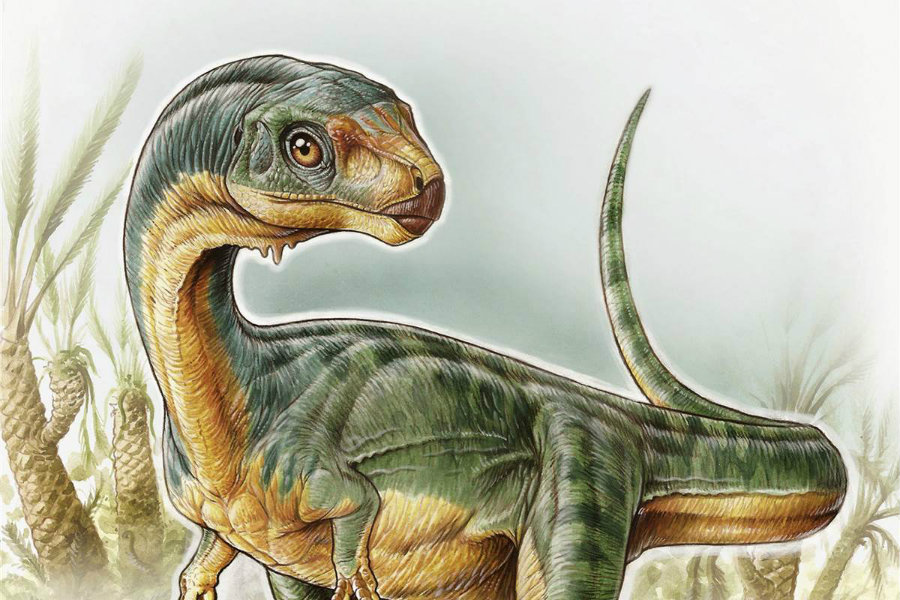The mysterious puzzle of the Frankenstein dinosaur, properly called Chilesaurus, has been solved after two years of hard researching, according to experts.
The Chilesaurus has caused intrigue within scientists due to its skeleton’s composition and bone order. It had many similarities not only with herbivore dinosaurs but also with carnivores. Now, according to a study published in the journal The Royal Society Biology Letters, scientists have a clearer knowledge of to which group it belongs.

Found two years ago in Chile, South America, the Frankenstein dinosaur had a head of a furious carnivore, but flat teeth that only let it eat plants. It used to walk on the Earth around 150 million years ago.
Brontosaurus, Stegosaurus, and Tyrannosaurus rex’s bones in just one dinosaur
For two years, this dinosaur represented a significant problem for investigators due to the many physical characteristics it had. The legs resembled the ones from a Brontosaurus, the hips from a Stegosaurus, and the arms and body from a Tyrannosaurus rex. Experts first thought the Chilesaurus belonged to the theropods, the “lizard-hipped” group of dinosaurs that includes Tyrannosaurus.
Scientists analyzed more than 450 anatomical characteristics to find its family tree. After all the studies and finally solving the puzzle, they decided to put it along with other dinosaurs completely unrelated to any of their kind: within the ornithischia group, where Triceratops and Stegosaurus are also found. Chilesaurus is one of the very first dinosaurs to be included in this “bird-hipped” group.
“We had absolutely no idea how the ornithischian body plan started to develop because they look so different to all the other dinosaurs. They have so many unusual features,” said Matthew Baron, a PhD student at Cambridge University. “In the 130 years since the ornithischia group was first recognized, we have never had any concept of how the first ones could have looked until now.”
One of the particularities of ornithischia group dinosaurs is their hip structure, which allowed them to have complex digestive systems. Although these systems were essential for the evolution of big herbivore dinosaurs, Chilesaurus lacked the distinctive beaks that other ornithischian dinosaurs had for eating, making it a likely transitional dinosaur that fills the gap between the two different groups.
Break in the dinosaur family tree
Paleontologists indicated this group is more connected with meat-eating dinosaurs, although of the many other plant-eaters that are also part of it. Due to a research published in the journal Nature, the family tree of the Frankenstein dinosaur is re-configuring – according to Mr. Baron -, converting the enigma into a missing link.

Scientists didn’t know in which order the ornithischia group’s characteristics evolved because, it’s believed, this group of dinosaurs was the first transitional specimens. Now, in bird-hipped dinosaurs, they assured that the gut evolved first, and the jaws evolved later.
“Now that we think ornithischians and meat-eating dinosaurs such as Tyrannosaurus are related, Chilesaurus slots exactly in between the two groups. It is a perfect half-and-half mix. So, suddenly in the new tree it makes a whole lot of sense,” said Mr. Barton.
After 130, the Ornithischia group is rearranged
According to Mr. Baron, this discovery represents a split in the dinosaur family tree due to the direction each dinosaur branch took. For the Chilesaurus, it might have been necessary to change its diet from meat to plants. This new alternative version of the dinosaur family tree, which is really just a rearrangement, it’s called “Baron tree.”
Along with Mr. Baron, other scientists are supporting the research. Prof Paul Barrett, from London’s Natural History Museum and co-author of the investigation, also believes Chilesaurus was a dinosaur that took a different direction when it evolved. He is certain this will soon make the world understands more of the Frankenstein dinosaur biology.
For more than 130 years, the group had not been re-configured by any reason. Although this family tree is very controversial, scientists are hoping this new finding will help differentiate the reason why Chilesaures decided to change the way it fed itself. Mr. Baron thinks the rescuing of Chilesaurus from its Frankenstein status could be just the first of a series reappraisals.
“We’ve landed a good punch against the counter argument here. This is a very good step towards my main objective which is to try to really nail down the ornithischian lineage because I think we’ve been completely misunderstanding and ignoring this very important group for far too long… Eventually, we’ll arrive at a consensus. I think this is a step toward the right model.” said Mr Baron
Mr. Barton and Prof Barret suggested that the entire dinosaur family tree should be re-configured because of the possibility that both major groups of dinosaurs descend from the same ancestor. Their suggestion could overturn over a hundred years of theory about the evolution of dinosaurs.
Source: The Royal Society Biology Letters
